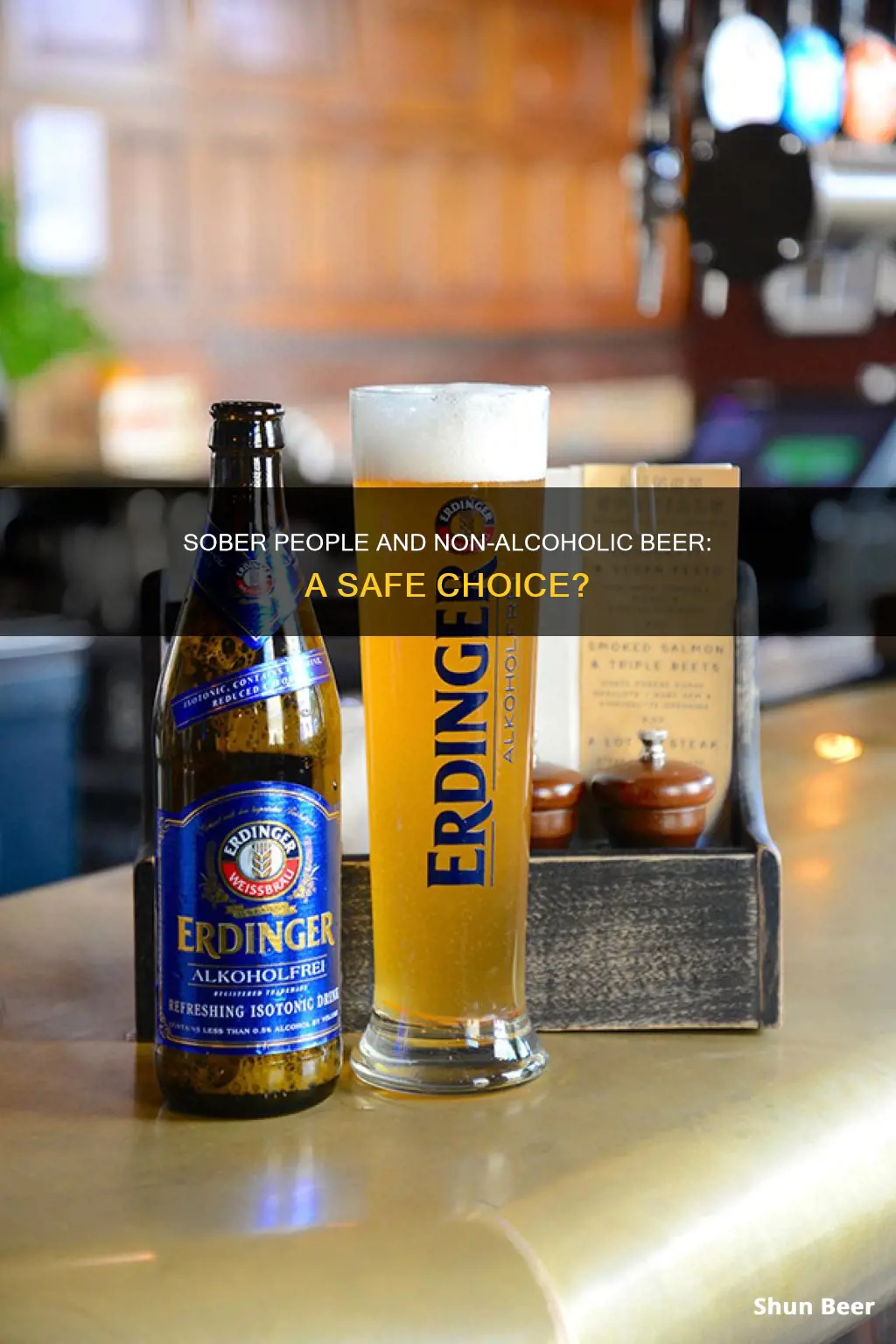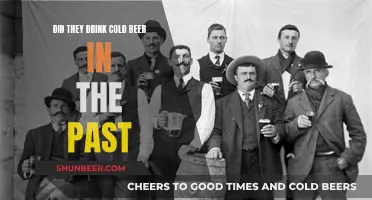
Non-alcoholic beer is a controversial topic in recovery communities. While some people in recovery find it helpful to have a non-alcoholic drink, others see it as a potential trigger. The decision to consume non-alcoholic beer during sobriety is usually a personal one, and it's important to be aware of the risks. Non-alcoholic beer often contains small amounts of alcohol, and the taste and smell can trigger cravings and a subsequent relapse, especially if consumed in social situations where alcohol is present. However, non-alcoholic beer can also provide a sense of normalcy and inclusion for those who want to enjoy the taste and social experience of drinking beer without the intoxicating effects of alcohol.
| Characteristics | Values |
|---|---|
| Alcohol content | Non-alcoholic beer contains very little or no alcohol. By law, non-alcoholic beers can have up to 0.5% ABV. However, products marketed as alcohol-free are required to contain 0.0% ABV. |
| Taste and appearance | Non-alcoholic beer is designed to taste and look like traditional beer. |
| Social benefits | Non-alcoholic beer can help sober people feel included in social situations where alcohol is present without compromising their sobriety goals. |
| Risks | Non-alcoholic beer may trigger cravings and emotional associations for individuals with a history of alcohol addiction, potentially leading to a relapse. |
| Individual factors | The decision to consume non-alcoholic beer during sobriety depends on individual factors such as triggers, support systems, and personal definitions of sobriety. |
What You'll Learn

Non-alcoholic beer may still contain alcohol
Non-alcoholic beer is often marketed as a safe alternative to alcoholic drinks, but it's important to be aware that it may still contain small amounts of alcohol. In the United States, beverages labelled as "non-alcoholic" can legally contain up to 0.5% alcohol by volume (ABV). While this is a very small amount, it's crucial to remember that it still constitutes alcohol, and for certain individuals, even this minimal alcohol content may be significant.
Research has shown that many non-alcoholic beers contain more alcohol than their labels indicate. A 2010 study found that 29% of no- or low-alcohol beers tested had higher alcohol levels than stated on their labels, with six beverages claiming to be alcohol-free containing more than 1% ethanol. This discrepancy can pose a risk to individuals who are trying to abstain from alcohol, particularly those with a history of alcohol addiction.
The presence of alcohol in non-alcoholic beer can be a concern for people in recovery from alcoholism. While the amount of alcohol in these beverages is typically not enough to cause intoxication, the psychological impact of consuming them cannot be overlooked. For some, the taste and ritual of drinking beer, even without the intoxicating effects, can act as a trigger, potentially leading to cravings for alcoholic drinks. The smell and taste of non-alcoholic beer may evoke memories of past drinking experiences, triggering a relapse.
Additionally, non-alcoholic beer can have important social implications for those in recovery. It can serve as a tool for social integration, helping individuals avoid alcohol without drawing attention to their abstinence in social settings. It allows them to participate in the social ritual of drinking without compromising their sobriety goals. However, for others, the presence of non-alcoholic beer in social situations may be a reminder of their struggles with alcohol addiction and could lead to feelings of isolation or pressure to consume alcoholic drinks.
In conclusion, while non-alcoholic beer may be a viable option for some, it's important to recognise that it may still contain alcohol. The decision to consume non-alcoholic beer during sobriety is a personal one and should be made with careful consideration of individual circumstances, triggers, and support systems.
Passengers and Beer: Drinking Laws You Need to Know
You may want to see also

It can be a trigger for people with alcohol addiction
Non-alcoholic beer can be a powerful trigger for people with alcohol addiction, creating cravings that can lead to a relapse. The look, smell, taste, and label of non-alcoholic beer are very similar to those of regular beer, and this can be a significant trigger for someone in early recovery. The sensory experiences associated with drinking beer can cause frustration and trigger a condition known as euphoric recall, a form of selective memory in which a recovering addict glamorizes their active addiction while ignoring the negative effects it had on their life.
Research has shown that the smell of beer alone may be enough to trigger cravings and a subsequent relapse among certain people with alcohol use disorder. In a study conducted by California scientists, rats were trained to self-administer alcohol when they smelled a certain odour. The researchers found increases in dopamine, a brain chemical associated with feelings of elation and pleasure, in the rats' brains before and after smelling these "alcohol-related cues". While this was an animal study, it suggests that similar effects may occur in humans.
Even a small amount of alcohol can trigger those in recovery to justify having a stronger drink or result in an addiction to non-alcoholic beer itself. The addictive potential of non-alcoholic beer lies in the psychological aspects, such as the routine, taste, or context associated with drinking, rather than the alcohol itself. For those with a history of alcohol addiction, drinking non-alcoholic beer might trigger cravings or lead to a relapse if it reactivates old behavioural patterns.
The decision to consume non-alcoholic beer during recovery is a personal one and should be made with caution. Individuals in recovery should consult with their healthcare provider, therapist, or addiction specialist before consuming non-alcoholic beer or any other products that may resemble alcoholic beverages. It is important to know one's triggers and avoid high-risk situations that could lead to a relapse.
Viagra and Beer: A Safe Mix?
You may want to see also

It can be a useful tool for social integration
For sober people, non-alcoholic beer can be a double-edged sword. On the one hand, it can be a useful tool for social integration, allowing them to avoid alcohol without drawing attention to their abstinence in social settings. This can be particularly helpful in situations where alcohol is present and the individual wants to participate without feeling left out or pressured to consume alcoholic beverages. Non-alcoholic beer provides a sense of normalcy and inclusivity, enabling people to enjoy the taste and experience of beer while maintaining their commitment to sobriety. It can also help them avoid questions about why they are not drinking and ease the social pressure to drink.
However, it is important to recognise that non-alcoholic beer is not completely free of alcohol. By law, non-alcoholic beers can contain up to 0.5% alcohol by volume (ABV). While this amount is negligible and non-alcoholic beer will not get you intoxicated, it is still something that sober people should be aware of. Additionally, the taste, smell, and ritual of drinking non-alcoholic beer may act as a trigger for some individuals, reminding them of past drinking experiences and potentially leading to cravings for alcoholic beverages. The concept of "near beer" may also be psychologically dangerous for those who miss the taste and act of binge drinking, potentially leading to a relapse.
The decision to consume non-alcoholic beer during sobriety is ultimately a personal one and depends on various factors. These include the individual's reasons for considering non-alcoholic beer, their definition of sobriety, their awareness and comfort with potential physical and psychological effects, and the input of their support network. It is crucial for sober individuals to assess their own triggers and consult with healthcare professionals or support groups to determine if non-alcoholic beer is a suitable choice for their unique journey.
Some people in recovery find that non-alcoholic beer helps them navigate social situations and feel included without compromising their sobriety. For others, the risks of triggers and cravings are too high, and they choose to avoid non-alcoholic beer altogether. The decision should be based on the individual's needs, goals, and comfort level with the potential risks.
Beer and Crestor: Is One Drink Okay Daily?
You may want to see also

It can be a personal decision, depending on individual circumstances
Whether or not a sober person can drink non-alcoholic beer is a highly personal decision that depends on individual circumstances. While non-alcoholic beer can be a useful tool for social integration, allowing individuals to avoid alcohol without drawing attention to their abstinence, it is important to consider the potential risks.
For some individuals, the taste and ritual of drinking beer, even without alcohol, can act as a trigger, potentially leading to cravings for alcoholic beverages. The smell and taste of non-alcoholic beer may be enough to trigger a relapse in some people with alcohol use disorder. This is because the act of consuming a beverage that resembles beer can trigger a placebo response, leading to sensations or emotions similar to those associated with alcohol consumption. Additionally, drinking non-alcoholic beer may remind individuals in recovery of past drinking experiences, potentially jeopardizing their sobriety.
On the other hand, non-alcoholic beer can help people feel included during social occasions without putting their sobriety at risk. It can provide a sense of normalcy and inclusivity, enabling individuals to enjoy the taste and experience of beer while maintaining their commitment to sobriety. For those in early recovery, non-alcoholic beer can help alleviate feelings of isolation and reduce the fear of being excluded or seen as different, which could contribute to a slip or relapse.
Ultimately, the decision to drink non-alcoholic beer while sober depends on various factors, including personal triggers, motivations, and goals. It is crucial for individuals to assess their unique circumstances and consult with healthcare professionals or support groups to determine if non-alcoholic beer aligns with their definition of sobriety and supports their long-term well-being.
Some specific circumstances where drinking non-alcoholic beer may not be advisable include court-mandated sobriety, specific addiction treatment programs, and specific medical conditions that necessitate complete abstinence from all forms of alcohol.
Hot Beer: Safe to Drink or Not?
You may want to see also

It may be perceived differently by people in support groups or recovery
The decision to consume non-alcoholic beer is a personal one, but it may be perceived differently by people in support groups or recovery. While some may view it as a helpful tool for social integration, allowing them to avoid alcohol without drawing attention to their abstinence, others may see it as a slippery slope that could trigger cravings and lead to a relapse.
For individuals in recovery, non-alcoholic beer can be a double-edged sword. On the one hand, it can provide a sense of normalcy and inclusivity, enabling them to enjoy the taste and experience of beer while maintaining their commitment to sobriety. It can be a useful tool for navigating social situations where alcohol is present, helping them feel included without compromising their sobriety goals. This is especially important in an alcohol-centric culture, where feelings of isolation and exclusion are common for those who do not drink.
On the other hand, the very same qualities that make non-alcoholic beer appealing can also be its pitfalls. The taste, smell, and appearance of non-alcoholic beer are designed to closely resemble those of traditional beer. For some in recovery, this can trigger "euphoric recall", bringing back memories of the good times associated with drinking. It can also activate psychological triggers and cravings, reminding them of past drinking experiences and potentially placing their sobriety at risk.
The recovery community itself holds diverse viewpoints on the topic. Some sobriety coaches and support groups advocate for complete abstinence from any beverage resembling alcohol, as it may blur the lines or increase the risk of relapse. Others take a more moderate stance, recognising non-alcoholic beer as a potential harm-reduction tool when consumed responsibly. Ultimately, the decision lies with each individual, who must consider their unique circumstances, triggers, and support systems when making an informed choice.
It is also important to note that while non-alcoholic beers are marketed as having little to no alcohol content, research suggests that many of these beverages contain more alcohol than their labels indicate. This can be particularly dangerous for individuals with liver impairments or those who are pregnant, as even small amounts of alcohol can have significant health consequences. Therefore, it is crucial for those in recovery to carefully evaluate the risks and benefits of consuming non-alcoholic beer and make a decision that aligns with their personal recovery goals and long-term well-being.
Beer and Metformin: What You Need to Know
You may want to see also
Frequently asked questions
Non-alcoholic beer typically contains 0.5% alcohol or less, so it's important to check the label. Sober people should consider their triggers and consult with healthcare professionals or support groups to determine if non-alcoholic beer is suitable for them.
Non-alcoholic beer may trigger cravings and emotional associations for people with a history of alcohol addiction, potentially leading to a relapse. It's important for sober individuals to assess their triggers and make an informed decision.
Non-alcoholic beer can provide a sense of normalcy and inclusion in social settings where alcohol is present, allowing individuals to participate in the social ritual of drinking without compromising their sobriety goals.
Alternatives include sparkling water, infused seltzers, non-alcoholic cocktails, herbal teas, craft sodas and colas, and infused water. These options provide a range of refreshing and hydrating choices without any alcohol content.







